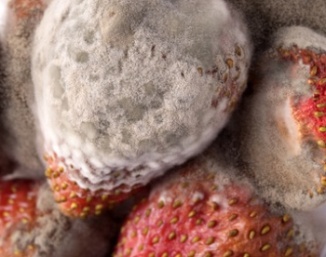Find a Mold Specialist Now
Click or Call, Toll-Free 24/7
Rhizopus Mold in the Home
Rhizopus is a common mold often found on bread, fruit, soil and dust. A slice of bread covered white or gray spots is actually full of this type of mold. It can cause a condition called soft rot in produce like strawberries, tomatoes and stone fruit like peaches and plums. You may see it growing on the soil of indoor plants, and it sometimes grows on dust, which can then spread to other areas in the house.

This is a fast growing mold. That’s why fresh foods seem to spoil so quickly. Rhizopus is one of the easier molds to spot and identify. It looks like a dense layer of cotton on the surface of the food. It starts out white and can turn gray or yellowish brown.
This type of mold is quite useful in medicinal and industrial settings. It is an important ingredient in the production of birth control pills by working to transform progesterone. It can also be used to manufacture cortisone, alcoholic beverages, tempeh and organic acids like lactic acid and fumaric acid.
Health Problems Caused by Rhizopus
Rhizopus is a known allergen and people sensitive to this type of mold may experience coughing, wheezing, runny nose or other allergy symptoms.
Most healthy people are not at risk for major health problems from encountering rhizopus. A rare but serious risk is a condition called mucormycosis. This illness occurs when this mold becomes airborne and enters the lungs or sinuses. It can also enter the bloodstream through open wounds. Burn victims are at risk of contracting this disease because their skin is so open to infection.
Mucormycosis can cause fever, cough, eye swelling and black discharge from the nose, among other symptoms.
People with weakened immune systems, due to diabetes, HIV, cancer or other condition, are most at risk of this infection. This illness is very serious, especially if it spreads to the lungs or brain, and needs to be treated with anti-fungal medication.
What Do You Do If You Find Rhizopus in Your Home
Because rhizopus is most often found growing on food, immediately get rid of any moldy food you find. Bag the food in plastic and put it in the trash. Don’t try to just cut away the moldy parts and eat the rest of the food. Some mold spores may be invisible and you don’t want to accidentally ingest it.
Although it doesn’t usually grow on household surfaces like wood or drywall, it can grow on dust and spread that way, so it’s important to get rid of it.
After you get rid of the moldy food, you’ll need to clean the area where the food was being stored, whether on the counter, pantry or in the refrigerator. You should vacuum using a HEPA vacuum to clear the dust on any exposed surfaces. Then use a damp wipe with low-toxicity cleaning product to wipe down the surrounding area.
If the moldy bread or fruit was stored in close proximity to other foods susceptible to mold growth, you may need to get rid of them as well. The U.S. Department of Health and Human Services offers this helpful chart for understanding safe food storage times to help avoid mold growth.
Removing Larger Mold Issues
If the mold has spread to other areas but isn't causing structural issues, you may decide that you can remove it yourself. Make sure you have the proper equipment, including personal protective equipment like gloves, goggles, a respirator mask, thick plastic trash bags to contain the mold as you clear the damaged area, and a vacuum with a HEPA filter. You may also want to set up a negative pressure environment where the air is constantly removed from the work area so any mold spores that become airborne do not spread to other parts of the home. Mold can easily become airborne and spread during removal if you don’t take proper precautions. Learn more about techniques and equipment.
If you are allergic to mold, or if you suspect mold is present in your household dust or is growing on your walls, floors or ceilings, or inside your kitchen cabinets, we recommend that you have an expert take a look. Your mold problem might be a lot larger than you realize.
Do You Need Professional Help?
Rhizopus mold is easier to deal with than other types of mold, and can typically be removed by homeowners themselves. But if damp conditions in your kitchen are contributing to the growth of food mold, then you should be on the lookout for other types of mold, too.
Unchecked mold growth can cause major (and expensive) damage to your home, and put your health at risk. Mold can cause nasal stuffiness, throat irritation, asthma symptoms and eye or skin irritation. Health problems can be worse for the very young, the very old, and people with compromised immune systems.
The sooner you recognize and treat mold in your home, the better. If you aren’t sure how to handle mold removal safely, we recommend that that you get a free home inspection from a mold specialist in your area. A mold specialist can identify mold problems in your home and make recommendations for removing the mold. You’ll receive a free estimate for professional mold removal.
You’ll also need to address the cause of the mold, such as poor ventilation or leaking pipes, so that it doesn’t regrow. The contractor will help with repairs to your home’s structure or plumbing to prevent future problems.
Return From Rhizopus To Our Main Mold Types Page
Privacy Policy Terms and Conditions Accessibility Do Not Sell My Information Disclaimer Contact Us




